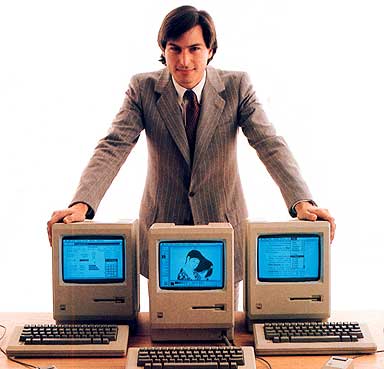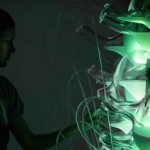“The use of computers in science now may bring images of data-crunching parallel processing and Unix-inspired open-source collaborations, but there was a time when the cutting edge — at least for molecular scientists — was being able to draw a benzene ring digitally on screen. Jobs and Apple gave scientists the power to do that, and more besides. Scientists responded with decades of loyalty and, on news of Jobs’s death, with tributes of their own.”
 In some fields, such as design and publishing, Macs reign supreme. Science, especially biology, is another area where Macs have been prevalent.
In some fields, such as design and publishing, Macs reign supreme. Science, especially biology, is another area where Macs have been prevalent.
I used my first Mac in college in 1984. It was the original, quickly replaced with a Fat Mac soon after (Boston College was a key Apple school). Soon after graduating, I bought my first Mac, a Mac II. I would use that Mac for almost 10 years to write my PhD thesis, organize my wedding, create some animations (2D and 3D), and write a book and countless short stories.
In the lab
In grad school (’89-’94), we had a zippy Mac SE and another small 9″ Mac (I don’t recall which) in our lab. My boss wrote software to render and animate DNA, for non-linear regression, and run the instruments in the lab (HPLC, pumps, and specs). We also used the computers to design and plan experiments, draw molecules, and keep our lab reagents catalogs (on HyperCard, of course).
In my post-doc lab (’94-99), we had fast, colour machines for writing papers, making slides, keep our reagents catalogs, email (big thing then), surf the new and burgeoning Web (on Mosaic and Netscape 1) for genomic info, ordering, DNA alignments, running instruments, and non-linear regression. The interesting thing is by my post-doc, there were software packages that could do all the things my grad-school advisor has programmed. Quite a change for someone like me who doesn’t program.
No more lab
I left the lab and eventually found my way to a PC-centric corporation – Nokia. I had a few Macs at home, but craved to use it once more at work. After about 5 years, I did get one, and, of course, it transformed how I worked. [Indeed, I used to point out that Nokia kept getting blind-sided by Apple because Nokia’s PCs acted as blinders as to what personal electronics could be like.]
When I left Nokia, I entered a media producer role with two zippy cutting-edge, totally loaded Macs with great software and screen real-estate.
But now, in my current job, I am back to PC-ville, though not so hobbled as in the old days – Windows 7 isn’t so bad (though nothing really works as polished as it does on a Mac – loads of examples), and I still use Firefox and Seesmic as I did on the Mac.
Of course, we still have a few Macs at home and I hope to return to using a Mac for business in the near future.
Lab Macs rule
In any case, I’ve used Macs in all sorts of settings and have suffered the PC world. And Mr Jobs has indeed transformed my life, as he did the lives of all the scientists I worked with. This retrospective of mine was triggered by the article quoted above (link below). It’s a nice commentary of how, even though Apple was trying to be the business computer of choice, it ended up being a strong force in science.
What do you think? How Mac-centric is your lab? Could you imagine doing science without Macs?
Read this article…
Image from MacRumors




